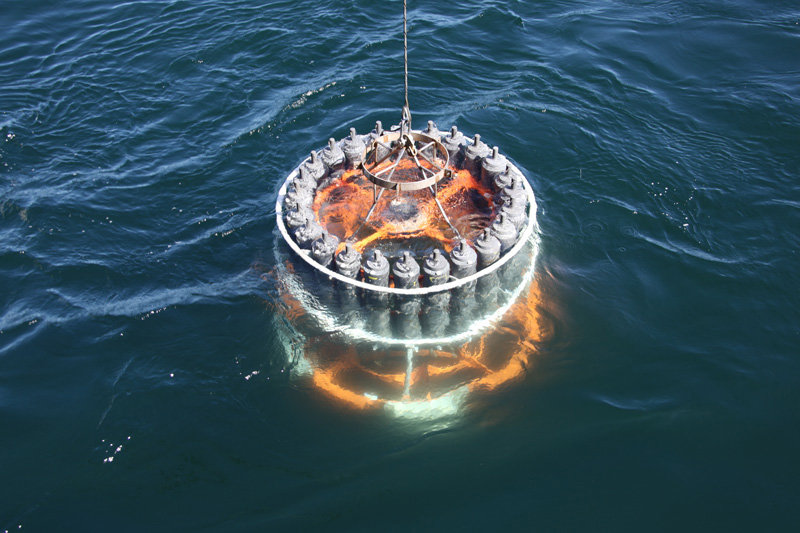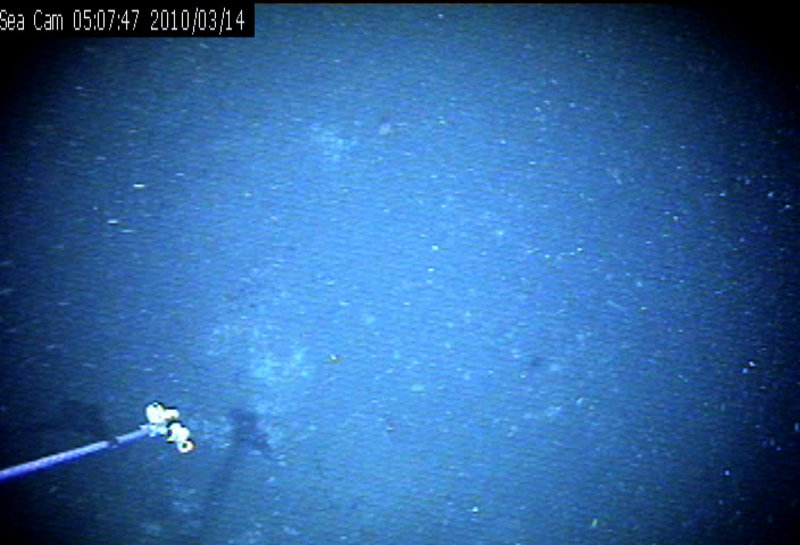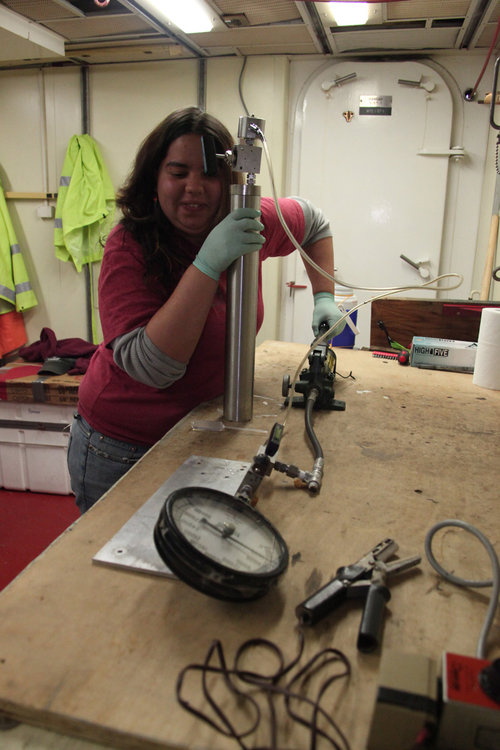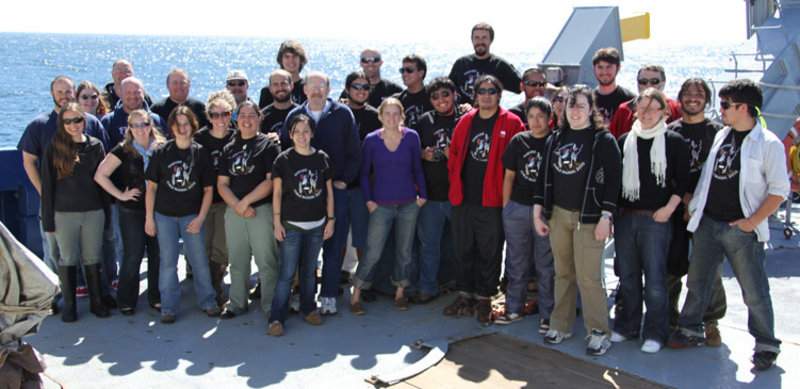
By Andrew Thurber - Expedition Chief Scientist, Scripps Institution of Oceanography
February 24 – March 17, 2010
During our 22 days aboard the research vessel (R/V) Melville, members of the INSPIRE: Chile 2010 expedition set out to explore four largely unknown regions of our planet, in search of missing links in our understanding of biology, geology, and chemistry within the deep ocean. Through untold hours of conductivity, temperature, depth (CTD) work — comprising 33 separate deployments, 26 bouts of multicoring, and 10 trawls — we sampled at depths between 350 and 6100 meters (up to 18,000 feet). Yet due to the nature of what we have collected, we will not know much of what there is to learn for months (or even years) as we process our invaluable samples.

Sometimes the little parts are not only pretty but can tell us about the life history of the animals we collect. For gastropods (snails), the shape of the tip of the shell can tell us whether this species disperses via larvae (which feed in the plankton) or feeds off their yolk. Image courtesy of INSPIRE: Chile Margin 2010. Download image (jpg, 70 KB).

The conductivity, temperature, dept (CTD) sampler was consistently our most successful instrument. We put it over the side of the research vessel Melville at all of the sites we visited. Image courtesy of INSPIRE: Chile Margin 2010. Download image (jpg, 128 KB).
In some ways, the cruise did not go as planned. One of the largest earthquakes ever recorded shook the coast of Chile during our voyage, humbling our knowledge of how the earth works and reinvigorating our quest to gain a better understanding of these regions. We also lost our autonomous underwater vehicle (AUV) early in its quest to uncover the world below.
The Chilean Triple Junction presented many challenges during this initial exploration. We found chemosynthetic (able to form organic compounds using energy released from chemical reactions) fauna and many areas with methane. While methane can indicate hydrothermal activity, it is also present at methane seeps. We currently do not know where, along the continuum of hydrothermal vents to methane seeps, many of our newly discovered sites lie. As we analyze the water we collected from within the potential hydrothermal plumes, the story will become clear. At that point, we will know if we have discovered our sought-after “hybrid” habitat.
In any case, we collected a bounty of biodiverse fauna throughout the 400 to 3,300 m (1,443 to 10,826 ft) deep water we sampled. One of the great advantages to exploring regions such as this is that all of these samples provide much needed information about this under-sampled area, including many new species of invertebrate (lacking a backbone) which to this day remain undescribed. Most surprisingly, we avoided the storms which make this region so difficult to study; we rarely had more than a rolling swell and a puff of wind.

This image shows a microbial mat (on the left) and carbonate rocks (right). It is one of the first images of this Chilean methane seep. Image courtesy of INSPIRE: Chile Margin 2010. Download image (jpg, 111 KB).
The Chilean methane seep area was strangely the most challenging area we visited. We knew the most about it before we showed up; yet consistent swells and the previous loss of the autonomous benthic explorer (ABE) meant our knowledge of where we were going was limited. In addition, the area we identified as having active seepage was difficult to core due to hard sediment. We also spent our time towing around in the dark — similar to towing a magnet through a haystack looking for a needle — taking pictures as we went and mapping out what we found. In the face of this adversity, we obtained a much better idea of the distribution of species in that region and the area of active seeping.
Perhaps our greatest find was a carbonate rock that was rich with species similar to those we have collected from areas of active seepage around the Pacific. As always, our water-column sampling was successful throughout. We found many small and large bursts of methane covering this very active margin.
At El Quisco methane seep we earned the distinct honor of collecting the first live chemosynthetic species ever from this region. By following the methane, our trawl collected multiple species of vesicomyid (seep) clams. In addition, we continued to map areas of methane release and seepage in this region, and, at the risk of sounding like a broken record, there was methane everywhere we looked.

Rosa Leon-Zayas forces pressure into her chambers which allows the microbes inside to survive for years to come. Image courtesy of INSPIRE: Chile Margin 2010. Download image (jpg, 111 KB).
The trench came and went in a sleepless fury of samples. This area lies a few six hours away from one of the greatest ports in the world, Valparaiso, yet has almost never had its 6100m depth sampled. We wrangled both mud and water from the bottom of the ocean yielding cool worms and enough microbes to study for years.
Separate from the specific science goals of this cruise, we had many other successes. An incredible hands-on class was taught to those students who were fortunate enough to join in this venture. We were also able to deploy the “budget” video-guided multicorer on its maiden voyage. This modification of a piece of robust, deep-sea sampling equipment was able to be guided into small areas on the seafloor and to map as we went. This system was all the more necessary after our AUV went missing. The system was designed and fabricated at the last hour by Carl Matson and Scott Hiller, both of whom work at Shipboard Technical Support at the Scripps Institution of Oceanography, on an unworkably small budget which they made work. Their willingness to support our science made this cruise a success for many of us.

The science party of INSPIRE: Chile Margin 2010. Image courtesy of INSPIRE: Chile Margin 2010. Download image (jpg, 117 KB).
During this cruise, we collected the first direct evidence of methane seep fauna from 46º south and the first live symbionts-bearing clams from an area which was known to be seeping; and we now know more than we have ever known about methane seeps and hydrothermal activity in the Chilean margin. In the end, this cruise was a success due to the incredible support we had from a fine ship, a hard-working crew, and the support of all on board and at home to make this work.